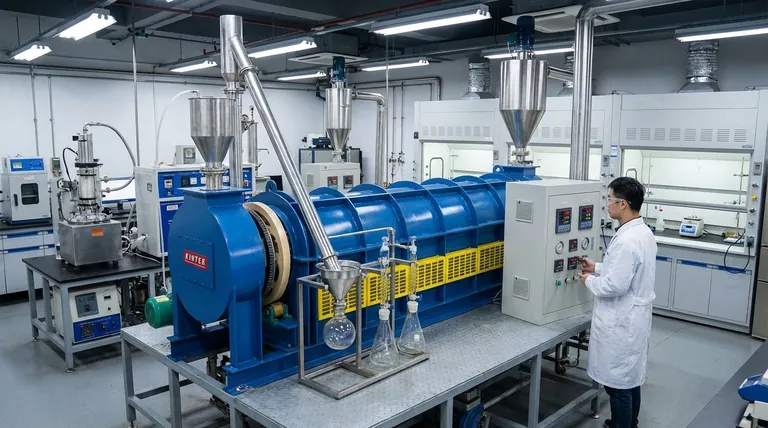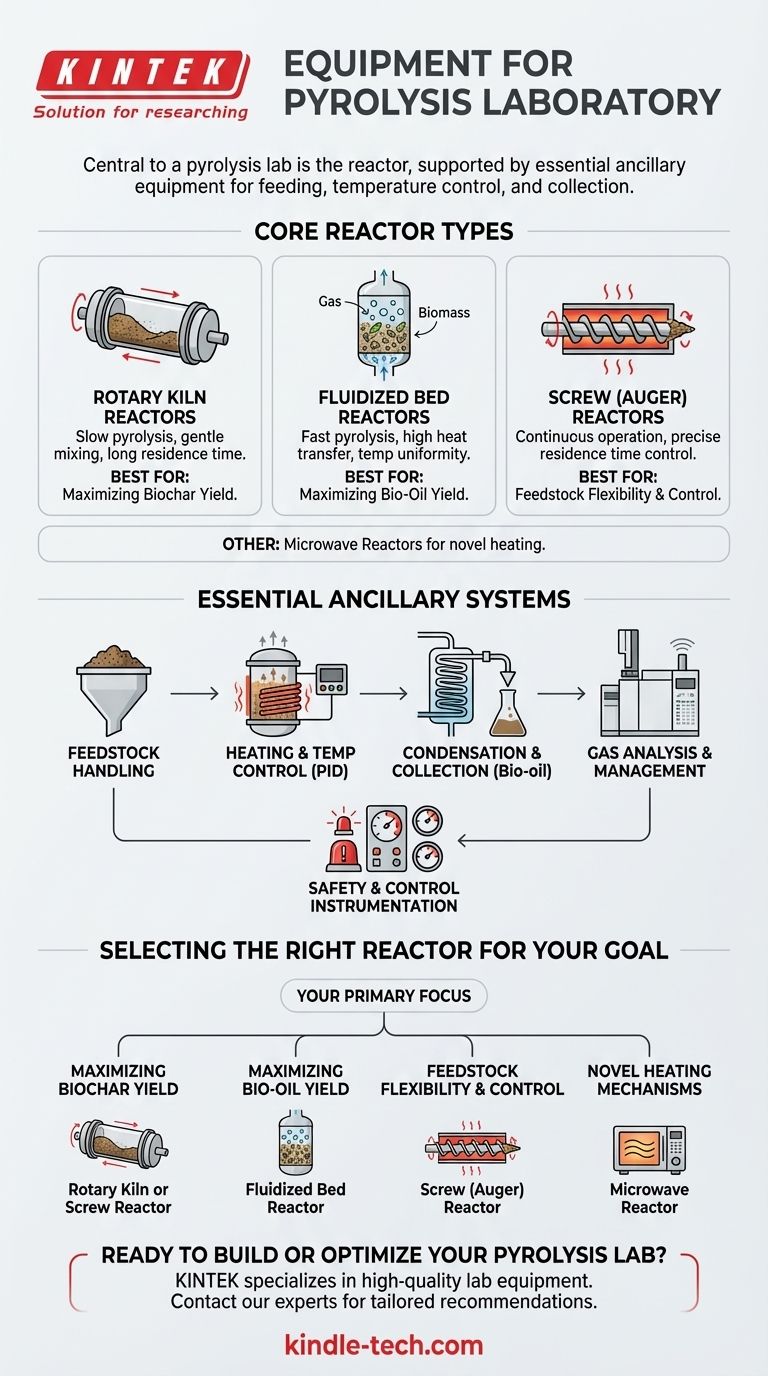In a pyrolysis laboratory, the central piece of equipment is the reactor, which heats organic material in the absence of oxygen. The most common types for research and development are rotary kiln, fluidized bed, and screw reactors. These systems are supported by essential ancillary equipment for feeding material, controlling temperature, and collecting the resulting products.
The choice of a pyrolysis reactor is not about finding the "best" one, but about selecting the right tool for the job. Your decision will be driven by your specific research goals, the type of material you're testing (feedstock), and whether you are optimizing for bio-oil, biochar, or gas production.

Core Reactor Types in Laboratory Pyrolysis
The reactor is the heart of any pyrolysis setup. Its design dictates heat transfer rates, processing time, and the types of feedstock that can be used, directly influencing the final product yields.
Rotary Kiln Reactors
A rotary kiln is a slowly rotating, cylindrical vessel. Biomass is fed into one end and, as the kiln turns, it tumbles through the heated zone.
This design ensures gentle mixing and even heat exposure. Its longer residence times make it particularly well-suited for slow pyrolysis, where the primary goal is often to maximize biochar production.
Fluidized Bed Reactors
In a fluidized bed reactor, a flow of hot, inert gas is passed up through a bed of solid particles (like sand) and the biomass feedstock.
This gas flow causes the solids to behave like a fluid, resulting in extremely high rates of heat transfer and temperature uniformity. This makes fluidized beds the industry standard for fast pyrolysis, which is used to maximize the yield of bio-oil.
Screw (or Auger) Reactors
A screw reactor uses a rotating auger to transport feedstock through a heated tube. The speed of the screw 몸precisely controls the residence time of the material in the hot zone.
This design offers excellent control and can operate continuously, making it a versatile option for both fast and slow pyrolysis. It functions like a conveyer belt moving through an oven.
Other Specialized Reactors
Less common but important for specific research, other reactors include microwave reactors. These use microwave energy to heat the feedstock volumetrically (from the inside out), which can lead to unique product compositions compared to conventional heating methods.
Essential Ancillary Systems
A functional pyrolysis lab requires more than just the reactor. A complete system includes several critical support components.
Feedstock Handling System
This includes hoppers and automated feeders (often screw-based) that introduce a consistent and controlled flow of raw material into the reactor.
Heating and Temperature Control
Precise temperature is paramount. This is typically achieved with high-power electric heating elements wrapped around the reactor, governed by a PID (Proportional-Integral-Derivative) controller and thermocouples for accurate feedback.
Condensation and Collection
The hot vapor and gas stream exiting the reactor must be rapidly cooled to condense the bio-oil. This is done using a series of heat exchangers or condensers, with the liquid bio-oil collected in flasks.
Gas Analysis and Management
Non-condensable gases are either sent to an analytical instrument like a Gas Chromatograph (GC) for composition analysis, vented, or flared for safe disposal.
Safety and Control Instrumentation
All lab-scale systems must be equipped with pressure gauges, temperature probes, emergency shut-offs, and alarms to ensure safe operation.
Understanding the Trade-offs
Choosing equipment involves balancing performance with operational reality. No single reactor type is perfect for every application.
Complexity vs. Control
Fluidized bed reactors offer superior heat transfer but are more complex to operate and can be difficult to start up and shut down. Rotary kilns are mechanically simpler but offer less precise control over a particle's heating journey.
Feedstock Limitations
The physical form of your feedstock matters. Fluidized beds require a narrow range of small particle sizes to work correctly. Screw reactors can sometimes jam with fibrous or irregularly shaped materials.
Scalability
While a lab unit is for generating data, the choice of reactor can impact how easily the process could be scaled to a larger, commercial-style pilot plant. Fluidized bed and screw reactors are generally considered more scalable than batch-style lab reactors.
Selecting the Right Reactor for Your Goal
Your research objective is the most important factor in equipment selection.
- If your primary focus is maximizing biochar yield: A rotary kiln or screw reactor is often ideal, as they allow for the slower heating rates and longer residence times needed for char formation.
- If your primary focus is maximizing bio-oil yield: A fluidized bed reactor is the standard choice due to its extremely rapid heat transfer, which favors the fast pyrolysis conditions necessary for liquid production.
- If your primary focus is feedstock flexibility and process control: A screw (auger) reactor provides excellent control over residence time and can handle a variety of materials, making it a versatile tool for general research.
- If your primary focus is exploring novel heating mechanisms: A microwave reactor allows for unique research into volumetric heating, which can offer different product distributions compared to conventional methods.
Ultimately, a well-equipped pyrolysis lab matches its core reactor technology to its specific scientific questions.
Summary Table:
| Reactor Type | Best For | Key Characteristic |
|---|---|---|
| Rotary Kiln | Maximizing Biochar Yield | Slow pyrolysis, gentle mixing, long residence time |
| Fluidized Bed | Maximizing Bio-Oil Yield | Fast pyrolysis, high heat transfer, temperature uniformity |
| Screw (Auger) | Feedstock Flexibility & Control | Continuous operation, precise residence time control |
| Microwave | Novel Heating Research | Volumetric heating, unique product compositions |
Ready to Build or Optimize Your Pyrolysis Lab?
Selecting the right equipment is critical to achieving your research goals, whether you're focused on bio-oil, biochar, or gas production. KINTEK specializes in high-quality lab equipment and consumables, serving the precise needs of pyrolysis research and development.
Our experts can help you navigate the trade-offs and select the perfect reactor system—including essential ancillary equipment for feeding, temperature control, and product collection—to ensure your lab's success.
Contact our specialists today to discuss your specific application and receive a tailored equipment recommendation.
Visual Guide

Related Products
- Electric Rotary Kiln Pyrolysis Furnace Plant Machine Calciner Small Rotary Kiln Rotating Furnace
- Electric Rotary Kiln Continuous Working Small Rotary Furnace Heating Pyrolysis Plant
- Electric Rotary Kiln Small Rotary Furnace for Activated Carbon Regeneration
- Electric Rotary Kiln Small Rotary Furnace Biomass Pyrolysis Plant
- Vacuum Sealed Continuous Working Rotary Tube Furnace Rotating Tube Furnace
People Also Ask
- What is the difference between calcining and roasting? A Guide to High-Temperature Processing
- What are the products of pyrolysis of wood? A Guide to Biochar, Bio-oil, and Syngas Yields
- What are the types of pyrolysis reactors used in industry? Choose the Right Technology for Your Product
- What are the zones in rotary kiln in cement production? Master the Core Process for High-Quality Clinker
- What equipment is used in pyrolysis? Choosing the Right Reactor for Your Feedstock and Products



















